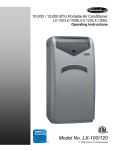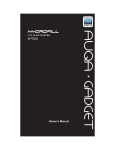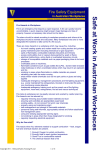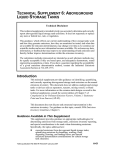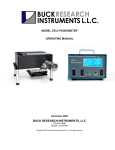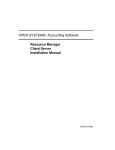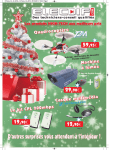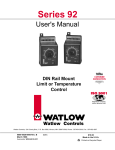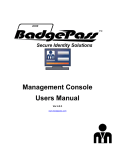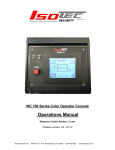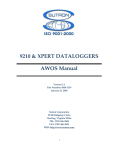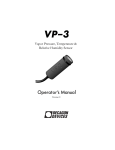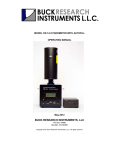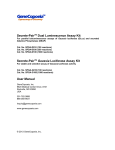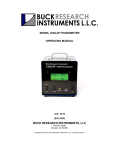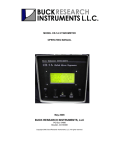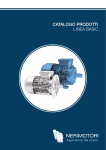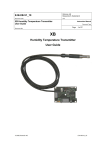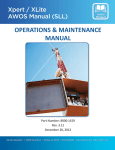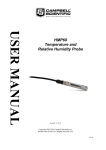Download User`s Manual - Buck Research Instruments LLC
Transcript
VAPORTRON ® H100BL/H100CL Series Precision Humidity Lab P P Users Guide – January 2012 BUCK RESEARCH INSTRUMENTS, LLC PO Box 19498 Boulder, CO 80308 © 2012. Buck Research Instruments, LLC All rights reserved Buck Research Instruments, LLC - VAPORTRON® H100BL/H100CL Series Table of Contents 1. INTRODUCTION Overview Specifications 2. THEORY OF OPERATION Philosophy of Design Relationship Between Dewpoint and Relative Humidity 3. INSTRUMENT DESCRIPTION Thermal Control System Humidity Control System 4. SETUP AND VERIFICATION 5. USE AND CALIBRATION General Practices Calibration Calibration of Sensors and Transmitters with the VAPORTRON Recommended Calibration Procedure (or Trial-Run) Sensor Response Analysis Sensor/Transmitter Adjustment Procedure Special Low-End Trim Other Guidelines Operating at High Relative Humidity Desiccant/Drier Cartridge Service Water Reservior Check and Water Service Procedure 6. TROUBLESHOOTING Chamber Too Moist or Too Dry Chamber Too Moist – No Control Chamber Too Dry – No Control No Control – L1, L2 Pump LEDs Lit APPENDIX Watlow Controllers Material Safety Data Sheets Sample Certificate of Calibration Humidity Related Tables Product Listing Warranty 1 3 3 3 3 3 3 5 6 8 10 12 12 12 12 13 13 14 15 15 15 16 17 18 18 18 19 19 20 22 26 27 29 30 Buck Research Instruments, LLC - VAPORTRON® H100BL/H100CL Series Appendix Watlow Controllers Material Safety Data Sheets Sample Certificate of Conformance Humidity Related Tables Product Line Description 2 Buck Research Instruments, LLC - VAPORTRON® H100BL/H100CL Series 1. INTRODUCTION Overview The VAPORTRON series calibration system is a high-performance, stand-alone temperature/humidity reference generator. It features a thermal servo system to stabilize temperature in the range of 15 to 60°C at ± 0.2°C stability. Relative humidity is rapidly generated in range of 3 to 95%RH at ± 0.2% RH stability. RH accuracy is ±1.5% at maximum between 20-90% RH At temperatures near ambient, a typical accuracy of +/- 1% RH is achieved. The chamber volume is 2 liters in a 12 cm (5 inch) diameter by 34 cm (7 inch) cylindrical space. A thermoelectric cooler provides a means of stabilizing the chamber working temperature at a differential centered near the ambient air conditions in the room.. The servo based humidity control provides a system with the precision needed for laboratory and research needs. It also provides the overdrive required for production operations where large surface area or multiple sensor calibrations are processed. Due to the design of VAPORTRON, the typical settling time to a 1% RH stability is only 2-3 minutes. Specifications MODEL # OPTIONS 15-60°C at ±0.2°C stability, as above with Watlow 96 PID, serial data link, RH & Temp, & software H-100BL H-100CL 2. THEORY OF OPERATION Philosophy of Design The VAPORTRON system was developed around a solid-state capacitive polymer sensor. This philosophy differs somewhat from conventional humidity generators as we rely on a carefully calibrated transfer-standard (the polymer) instead of "first principal" methods, i.e. gravimetric, two-pressure, divided flow, dewpoint referenced feedback, etc. The VAPORTRON system excels for the following reasons: • • We generate relative humidity directly (via servo action against the reference), thus no calculations or conversions are required to read out the chamber humidity. The chamber environment is AT the humidity displayed on the readout panel. The reference sensor output is monotonic. There is no secondary control system to hamper or distort the sensor response to changes in moisture. This provides for a controlled, rapid approach to the desired humidity and a stable humidity output thereafter. 3 Buck Research Instruments, LLC - VAPORTRON® H100BL/H100CL Series • There is no phase change ambiguity or oscillation introduced when the dewpoint, measured or generated, goes below 0 °C. • A wide dynamic range of chamber output is possible. The 2-98% RH range corresponds to a -24 to +24 ºC dewpoint range. • The polymer is immune to dust and salt contamination and requires little maintenance. A six month to one year service period is typical for 1% accuracy. • The polymer reference sensor is approximately 1/10th the cost of a chilled mirror hygrometer of similar sensing accuracy. It is compact, rugged, and produces no waste heat in the chamber. This allows us to offer a complete temperature controlled generator package for a price comparable to our most affordable chilled mirror hygrometer. • The VAPORTRON system takes advantage of the high stability and physical durability of the world's best polymers. Only ROTRONIC premium sensors meet the stringent standards required for use in the VAPORTRON. • This system was designed with generation of relative humidity as a major concern. For this reason, it excels at development, calibration and evaluation of other RH sensors. The great speed and precision of the VAPORTRON servo type generator saves both time and cost. • VAPORTRON is ideal for industrial or commercial transmitter calibrations where multiple sensors can be calibrated at once, with exceptionally low unit-to-unit variation. As standard final certification, we verify each VAPORTRON output RH using a CR-4 chilled mirror hygrometer and a Rotronic Hygropalm. Both hygrometers support better than 1% RH accuracy in this range. This comparison allows NIST traceability for our systems. Relationship between Dewpoint and Relative Humidity Figure 1 was calculated from the Clasius-Clapeyron general equation with the Goff-Gratch equivalent integration, and used in a computer program developed at Buck Research. Shown is the exponential dependence of dewpoint when RH is used as the reference input (or vice versa). This curve should be consulted when trying to cross -reference humidity measuring instruments of different types. As can be seen, when generating high RH levels, a corresponding high accuracy should be realized in dewpoint (due to the shallow slope). Conversely, a small RH change at the dry end can result in large dewpoint changes. 4 Buck Research Instruments, LLC - VAPORTRON® H100BL/H100CL Series Figure 1. Relative humidity vs. dewpoint at a fixed air temperature of 25 °C 3. INSTRUMENT DESCRIPTION Figure 2 shows the 2.0 L working volume of the chamber. It consists of a 12 cm diameter by 34 cm long insulated plastic cylinder. The chamber is designed as an isothermal mixing vessel with a small turbo-axial fan stirring air inside it. A high-efficiency heat sink is situated near the main cabinet fan (outside of chamber) for thermal exchange of heat to/from the outside. Located between the chamber internal heatsink and the cabinet heat-sink is a high capacity Peltier cooler (Model -Ll single stage, -L2 dual stage) which is operated conservatively at 5 volts and approximately 2.5 to 5 Amps (15 to 30 watts). Figure 2 Photo of inside of the 2 liter workspace. RH reference sensor is on top, PT-100 sensor is on the bottom 5 Buck Research Instruments, LLC - VAPORTRON® H100BL/H100CL Series Thermal Control System The thermal design of the VAPORTRON is depicted in Figure 3. The chamber temperature is maintained by a Watlow series 965 (for -BL models) and Watlow 96 (for -CL models) microprocessor based PID controller (see Appendix for details on Watlow controllers). The controllers measure a platinum resistance sensor element that is placed in the chamber vessel near the rear center. Chamber setpoint is made via the controller digital front panel, which has a 0.1 °C resolution. The PID controller maintains the chamber internal air temperature at a +/- 0.1 °C stability. The PID controller applies PWM (pulse-width-modulation) signals to the bases of a power MosFET driver transistor array. The FETS operates as current switches to the Peltier module attached to the chamber heat-sink. The Peltier module’s heat-pumping is automatically bidirectional in polarity. That is, either heating or cooling is possible, depending on environmental conditions. This configuration allows the maximum thermal efficiency as well as fastest chamber temperature rate of change when needed. The PID controller can be set from 0 to +50°C (60°C for –L2) by simply pressing the up or down arrows to change the setpoint. The chamber will typically arrive at a new stable temperature within 3 to 5 minutes after changing the command value. Up to 20 minutes should be allowed at the coldest and warmest program temperatures. The “M” and "A/M" buttons are disabled and have no function in this configuration. The temperature output of the temperature sensor in the Rotronic probe is amplified and scaled to degrees celcius ranges and is available at the rear panel as a recordable analog output The range is 0-5 V for 0 to 100°C 6 Buck Research Instruments, LLC - VAPORTRON® H100BL/H100CL Series Figure 3. Thermal design concept diagram for VAPORTRON. 7 Buck Research Instruments, LLC - VAPORTRON® H100BL/H100CL Series Humidity Control System The VAPORTRON humidity control scheme is essentially a reference based, closed loop servodemand flow network (see Figure 4). After being thermally stabilized by the system described in Figure 4, the working volume (2.0 Liters) is essentially a continuously stirred constant temperature atmosphere. The present relative humidity is sensed by a high grade, fast response polymer type reference sensor located approximately in the center rear third of the chamber. The RH signal is compared by an error amp processor inside the RH PID controller to its LED indicated set-point (command) as input by the user. Rotronic Hygroclip S or S2 Figure 4. VAPORTRON H-100 B Humidity Control Drawing. If the chamber RH compares lower than desired, a proportional PWM signal is output by the controller to a solid state 120 VAC (or 230 VAC for non-US models) relay which in turn feeds a small AC type diaphragm pump (PW). The pump draws chamber air, pumps it through the specially designed saturator vessel and outputs it back into the chamber. The output is vented directly into a 20 lpm internal circulator fan such that rapid molecular mixing occurs inside the chamber working volume. 8 Buck Research Instruments, LLC - VAPORTRON® H100BL/H100CL Series Conversely, if the reference sensor senses a humidity that is moister than the present setpoint, a PWM error signal is output by the controller to another SSR which in turn powers a separate pump. The PD pump flow is essentially in parallel with the wet side, but they do not operate at the same time. The dry side pump feeds chamber air into a Calcium Sulfate filled cartridge which dries the air to a 0.2% RH or a dewpoint of approximately -40 C. Molecular sieves can also be used in the cylinders for better dry-end performance. Silica-gel, while slightly less efficient, can be used for minimum particulate generation when feeding Raoult-sensitive sensors. Finally the air is again mixed thoroughly with the chamber air upon its entrance. Because of the servo nature of this system, the chamber responds rapidly to either a change in setpoint or a sudden change in chamber humidity loading. The servo pumps provide an ample overdrive capability such that only 2-3 minutes are required for most step changes in command value. At the extreme ends (<10% and > 90% RH) the system can take 10-15 minutes to reach the desired humidity. This is due to reduced drive differential and chamber container (and any contents) surface uptake/outgassing at each end of humidity extremes. Typical control errors (deviation from setpoint) are +/- 0.1% RH from 10 to 90% RH setpoint to around 1% error at the ends of the controlled range (3 to 98% RH). To allow for near 100% RH at chamber temperatures of 25 C and above, the vapor saturator is electrically heated. Additionally, a very low heat is maintained on the saturator delivery plumbing to ensure that condensation limits are above ambient temperature. 9 Buck Research Instruments, LLC - VAPORTRON® H100BL/H100CL Series 4. SET UP AND VERIFICATION The VAPORTRON control functions are shown in Figure 5. A description is listed roughly from Left to Right in Table 2. See Appendix (pages A-1 and A-2) for detailed description of temperature and RH controllers. 1. Unpack the VAPORTRON from the shipping carton and protective carrying case. 2. Remove the power cord and desiccant cartridge from side pouch and make sure the line voltage is correct. Plug power cord into power outlet. 3. Unfold desiccant holder hooks at rear panel, install fresh cartidge and connect plastic hoses to each end of the cartridge. (Place silver cap to INSIDE end of machine). 4. Switch on POWER (lower left). Both “RH DISPLAY” (green upper digits) and “TEMPERATURE” display (red upper digits) should read the approximate room conditions. Open white chamber for a few seconds. The RH reading should rise a few percent as the internal reference sensor responds to your skin humidity. 5. Replace door and install rubber stopper in aluminum port fitting (a test sensor may be inserted instead; seal around any cracks using the clay as provided in the kit). 6. Switch on “CONTROL”. A muffled, high pitched sound should indicate proper operation of air circulator fan inside the chamber. The command or setpoint is read and adjusted in the lower displays. Press the UP and DOWN ARROWS to change the command humidity – set the RH command between 20 and 80% RH and allow 5 seconds for the new command to be updated. The setpoint for temperature is similarly adjusted using the UP and DOWN ARROWS. Set point is read off the lower display. Use a set point of 25.0 C to start out (i.e. use a value close to ambient temperature). 7. The VAPORTRON displays should begin to ramp toward the values that were set. Normally, the RH reading will stabilize within 10-60 seconds when the value desired is within 10% to 90% RH. The red L1 and L2 LEDs (right side or top of each controller) will indicate when moist or dry air is pumping into the chamber. 8. The temperature control may take from a few minutes up to approximately 15 minutes near the extreme range ends. At room temperature, normal achievable control control range in the chamber is 15 to 50oC (L1), 10 to 60oC (L2). 9. The VAPORTRON has been filled with an adequate supply of distilled water for approximately 1 month of normal operation. However, check the rear panel reservior window weekly. 10 Buck Research Instruments, LLC - VAPORTRON® H100BL/H100CL Series Figure 5. VAPORTRON H-100BL front panel. Table 2. VAPORTRON control functions POWER Powers up all measuring and readout displays. All control systems are SWITCH disabled. Chamber is "floating" and is allowed to reach equilibrium with ambient air. CONTROL Enables both temperature and RH Controllers. Turns on internal chamber fan. SWITCH RH (Watlow model 965A) CONTROL TOP GREEN LED; 0-100% RH display of chamber RH LOWER GREEN LED: RH command or setpoint value UP/DOWN ARROWS: press to raise or lower RH command DRY AIR; is on when red L2 led blinks on WET AIR; is on when red Ll led blinks on TEMPER(Watlow model 965A) ATURE TOP RED LED; 0-50 ºC (L1) air temperature CONTROL BOTTOM RED LED; 0-50 ºC air temp COMMAND VALUE UP/DOWN ARROWS: press to increase or lower temperature COOLING: is on when red Ll led blinks on HEATING: is on when red L2 led blinks on DISPLAY RANGE: limited to 0 to 50 (or 60) ºC. ACTUAL CONTROL RANGE: 15 TO 50 ºC (L1), 10 TO 60 ºC (L2) CHAMBER The main circular door is approximately 5 inches on the inside. The door is DOOR AND normally fitted with a single 25 mm (actually 26 mm clearance) gland sealed PORTS type access fitting. optionally, two ports can be supplied on the door. Port fitting size adaptors are available for most commonly available sensor probes, typically; 12, 13 mm; TESTO and VAISALA small diameter 3/8 inch; Hy-cal probes 15, 16 mm; Rotronic small probes 18 mm ; Vaisala large (HMP-35 series) 20, 21 mm; TESTO large diameter 11 Buck Research Instruments, LLC - VAPORTRON® H100BL/H100CL Series 5. USE AND CALIBRATION General Practices For best dewpoint accuracy, the user is urged to use the output from the air-immersed PRT temperature sensor that is co-located with the RH sensor. This allows for actual AIR temperatures to measured from the place where the RH level is slaved. Some general practices to observe include: • To minimize mixing with ambient air and RH over/underload, temporarily shut off the Control Switch when opening chamber door. • Keep RH setting low (20-30%) when changing chamber temperatures ESPECIALLY WHEN COOLING DOWN. • Before chamber shutdown, set RH to a low value (20-30%) to avoid condensation inside chamber during storage. • Replace humidifer level with distilled water as required (typically once per month is adequate). • Use LAB ALGAECIDE or 1 DROP of Clorox (chlorine bleach) per filling to inhibit mold. The water tank is accessed by removal of red rubber cap at the center of the rear panel. • Add water slowly with a small syringe. Typically, add only 20 cc of water. * WARNING * IF THE WATER LEVEL IS OVERFILLED (SEE ROUND WINDOW AT BOTTOM REAR PANEL) LIQUID WATER MAY BE INADVERTENTLY PUMPED DIRECTLY INTO THE CHAMBER WORKING VOLUME! ** BE CAREFUL** Calibration CALIBRATION OF SENSORS AND TRANSMITTERS WITH THE VAPORTRON In the past, the most widely used method for RH calibration has been with saturated salts. With salts, it is possible to attain sub 1% RH accuracies but usually at the expense of a lot of time spent on the slow equilibration times, especially above the 75% RH level. An additional related problem is that most sensor/electronic combinations exhibit interactions between the calibration adjustment points. When long times are needed for the salt and the sensor to stabilize, it is not usually time-efficient to properly address the interaction problem (i.e. through iteration). With the VAPORTRON system, we have chosen to accept slightly less final generation accuracy, (circa 1.5%) but to greatly accelerate the time to change RH values and associated settling times. 12 Buck Research Instruments, LLC - VAPORTRON® H100BL/H100CL Series The VAPORTRON stabilizes to a new RH value from 10 to 100 times faster than most salt derived methods. The benefit of this is that the product of calibration throughput and final accuracy is greatly enhanced. In addition, due to the speed of generation, it is possible (and normally expected in metrology practice) to provide an “as found-as left" record of sensors tested, so that post-deployment corrections can be applied if needed to the sensor data. One other advantage is that (especially through automated ramp and soak option) it is easier to identify faulty or non-linear sensor output and deal with it BEFORE a lot of personnel time is wasted on attempting calibration of a malfunctioning sensor! RECOMMENDED CALIBRATION PROCEDURE (OR TRIAL-RUN) For a typical "as found" or exploratory run, we advise to start at low RH (typically 20 or 30% RH). Allow the Devices Under Test (DUT's) to sit in the VAPORTRON chamber for 2 minutes for every Deg C difference between room temperature in the lab and the VAPORTRON chamber temperature. As a rule of thumb -- 5 minutes is usually enough at low RH. Once the temperature is fully stable (use the readings of the DUT's temperature output if available) follow the procedure below: 1. Note or log sensor readings at the low RH 2. Command a mid-range RH value of 50% RH and after 5 minutes (minimum) and record sensor readings. 3. Command a high-scale or "span-check" of 70 to 80% RH and allow another 5 minutes, again record the sensor values. 4. Finally, set the VAPORTRON for an RH of 90 or 95% and allow the sensors approximately 10-15 min to "soak". Record the sensor readings after 5 minutes and again at 15 minutes. Most normal RH polymers will show a small upward "creep". However, this change in RH should be less than 0.5% RH. 5. Return the VAPORTRON RH to the initial low RH and allow 10 minutes for full stabilization. SENSOR RESPONSE ANALYSIS Plotting the four recorded measurements from the calibration procedure on a linear-linear graph will make it easier to determine if sensor adjustments are necessary. The lines behavior and suggested adjustments are as follows: If a DUT output shows a constant "offset" to a perfect 1:1 line (curve A on Figure 6) - adjust the DUT’s "zero" or "low RH" potentiometer. If a DUT shows an output that crosses the straight line but is either flatter or steeper than 1:1 (curve B on Figure 6) – adjust both the DUT’s "zero" and "span" (or "HIGH") potentiometer. If a DUT shows a "hump", “sag”, or severe non-linearity through the middle of the range (or excessive slope above the 75% to 95% range) then an iterative/compromise set of adjustments 13 Buck Research Instruments, LLC - VAPORTRON® H100BL/H100CL Series will need to be made to get a best fit. If it is necessary to have the ideal sensor response at a restricted RH range, the non-linearity may be ignored. Sensor Linearity Graph Ideal (1:1) 100 90 B RH Reading (%) - Sensor 80 70 Ideal (1:1) 60 A B A 50 C C 40 30 20 10 0 0 20 40 60 80 100 Actual RH (%) - VAPORTRON Figure 6. Sensor linearity curves. Sensor curve A can be corrected by adjustment of “offset” only. Sensor curve B can be corrected by both “offset” and “span” adjustment. Sensor curve C linearity cannot be corrected, however closer average agreement to “ideal” can be made by lowering “offset” and raising the “gain” setting slightly. SENSOR/TRANSMITTER ADJUSTMENT PROCEDURE Once a preliminary analysis is made through the pre-calibration and exploratory runs, use the following steps to calibrate the sensor/transmitter: 1. Adjust each DUT's "low" or "zero" to within 1% of the actual VAPORTRON RH. (Assuming you are still at the 20-30% RH step) 2. Set the VAPORTRON to the "high" end point where you want to optimize the slope or "span" of the sensor (i.e. 75 to 80% RH), allow 10 minutes soak time, then adjust the "gain" or ''span" potentiometer of the DUT for within 1% of actual RH. 3. Return to the dry end, wait 5 minutes and make a final (usually < 0.5%) adjustment to the "zero" adjustment. 4. If necessary, return to the High RH and make a final trim to the span. 14 Buck Research Instruments, LLC - VAPORTRON® H100BL/H100CL Series 5. Set the VAPORTRON to mid-scale (50%) and allow sensors to stabilize. It is at this point that true sensor linearity can be tested and any compromise adjustments can be contemplated. Usually the "low" or "zero" adjustment is may now be trimmed to allow for a "split-the-difference" trade-off deviation to be made for the low and high-end RH regions. SPECIAL LOW-END TRIMS Some sensor/transmitters, especially for industrial ovens or dryers will have an additional adjustment for the very dry end of the RH spectrum (usually in the 5 to 10% RH range). Once the general output is adjusted as per the above sequence, it is safe to make minor adjustment trims by setting the VAPORTRON to approximately 10% RH and allowing 15 minutes for dryout, then adjusting the special "LOW" or "DRY" potentiometer. If a total change is 5% or more in this region, it is advised to again return to the normal 20-30% range to verify that circuit interaction is not excessive (> 0.5 to 1%). Other Guidelines OPERATING AT HIGH RELATIVE HUMIDITY This calibration chamber is designed for optimum performance near or slightly above the ambient air temperature. The unit will generate RH at cooler and warmer temperatures but at some sacrifice in the range of humidity output. (The RH range that is possible will be narrowed at both the moist and dry ends by 10% or more.) When operating the system at very high RH levels (>90%), it is important to realize that gradients in temperature (i.e. cold surfaces) can cause condensation of liquid water on that surface. When this occurs, attempting to maintain or increase the RH setting will only cause more condensation and the actual air-volume humidity will remain the same. In other words, the limits of high RH operation will depend on how much cooling is being demanded of the heat-exchanger. The most reliable way to get RH values above 90%RH is to set the chamber temperature a little above ambient (1-2 ºC) and start by increasing the RH command by 1%RH intervals. Each time after the %RH value stabilizes, decrease the %RH value by 1%RH. If the chamber responds quickly, then increase the RH command by 1%RH and continue increasing the %RH value by 1%RH increments. When the chamber no longer quickly responds to a decrease of 1%RH, then it is at or near physical saturation. It is also wise to make sure the chamber is stable and not oscillating or ramping in temperature when running at high RH levels. 15 Buck Research Instruments, LLC - VAPORTRON® H100BL/H100CL Series Verify that a problem with condensation is occuring by commanding a -5 to -10% RH step setting temporarily. Watch the RH display. If it freezes or holds at the previous high RH reading for a long time before responding to the new setpoint there is a condensation problem. The slow response is evidence of water puddling as the system waits to evaporate liquid water from the walls. DESICCANT/DRIER CARTRIDGE SERVICE The plastic desiccator tube holds enough material to run the VAPORTRON typically for one month. (See Figure 7). The dryer material gradually turns from dark blue when dry to pink or greyish white when depleted. Normally a sharp contrast is seen when using granular CALCIUM SULFATE material between the depleted and fresh section (depletion is from left to right from back view). Replenish desiccant when edge of pink color approaches 2 cm (1 inch) from the right end of drying tube (on rear of instrument); use only DARK BLUE, ultra dry desiccant (approx. 1 month operating time is normal service per charge). Keep covers on desiccator cartridge if it is stored while NOT connected to the VAPORTRON system hoses. For VAPORTRONs with the dew point option (-DP), we normally supply the desiccator tube filled with ½ molecular sieve and ½ calcium sulfate . The molecular sieve dries the air by a mechanical method as opposed to chemical and is less “dusty”. This allows longer use of chilled mirrors before mirror contamination occurs. We advise to change the desiccant at 1 inch to left of the red line when using the molecular sieve filled drier cartridges. Figure 7. Rear panel with desiccant cartidge correctly installed. 16 Buck Research Instruments, LLC - VAPORTRON® H100BL/H100CL Series WATER RESERVIOR CHECK AND WATER SERVICE PROCEDURE The VAPORTRON internal vapor saturator/ water reservior is designed for long service between re-fills. Depending on the amount of use, the normal refill of water should last from 4 to 6 weeks to only to 1 week for continuous use or heavy cycling from hi to low RH levels. To check the water level, remove the desiccant cartridge and look into the large window near the left desiccant hangar hook (see Figure 8). Use the small inspection lamp supplied in the service kit. If necessary, tilt the VAPORTRON chassis fore/aft or left/right about 20 degrees. This may help to visually locate the water level. Figure 8. Water guage window location (left). Detailed figure of guage window decal (right). The water level must be between to lower and upper red lines on the fill level decal. NEVER ADD MORE THAN 30 CC OF WATER. When available, use distilled water, otherwise use clean tap water or bottled water. A blunt-needle syringe was included in the service kit to aid in filling the reservior. Always re-install the small cap after adding water. 17 Buck Research Instruments, LLC - VAPORTRON® H100BL/H100CL Series 6. TROUBLESHOOTING In normal operation, the control system will respond quickly to bring the RH reading to very close to the digital command LED setting. If the pumps run for a long time and/or the RH reading does not quickly settle in, it could be caused by the following: (First, shut off main power for 1 second, then back on. This action assures immediate re-entry of correct setpoints in case the system has been left idle with the CONTROL switch off.) CHAMBER TOO MOIST OR TOO DRY Possible Cause Suggested Action Leaks in or near the chamber door or through Check and apply clay or tape shut. rubber port gland or rubber stopper. Open return fitting (no cover or hose on fitting) Replace cover or tape the fitting shut. on "SAMPLE RETURN". Abnormally cold or hot chamber temperatures. Bring chamber close to ambient temperature, see if control improves. CHAMBER TOO MOIST - NO CONTROL Possible Cause Condensation on chamber walls. Suggested Action Open chamber, wipe walls with dry cloth, allow to air-dry for 5-10 minutes. Desiccator cartridge used-up (all pink or grey Check desiccator cartridge. Replace if all pink in color) or has become physically or grey. Reconnect hose if disconnected. disconnected from the chamber hoses. * Note that the system can actually work without the dryer connected, but the chamber will be limited to = or > than whatever the prevailing room humidity is! Hygroscopic load! Some materials have Remove any objects you suspect could be too TREMENDOUS water capacity in the vapor hygroscopic. phase, eg; Nylons, PVC plastics, and woods etc. 18 Buck Research Instruments, LLC - VAPORTRON® H100BL/H100CL Series CHAMBER TOO DRY -- NO CONTROL Possible Cause No liquid water in saturator vessel Suggested Action Check back sight glass and tilt cabinet front to back to confirm the water level Cabinet of VAPORTRON unit too cold Allow system to run in the power-on only (no control) for a period of time. Hygroscopic load! Some materials have Remove suspect material TREMENDOUS water capacity in the vapor phase, eg; Nylons, PVC plastics, and woods etc. NO CONTROL -- L1, L2 PUMP LEDS LIT, BUT NO REGULATION Possible Cause "CONTROL" switch not activated. Electronic failure. Suggested Action Check that it is pressed on Consult technical documents or the factory 19 Buck Research Instruments, LLC - VAPORTRON® H100BL/H100CL Series 20 Buck Research Instruments, LLC - VAPORTRON® H100BL/H100CL Series 21 Buck Research Instruments, LLC - VAPORTRON® H100BL/H100CL Series 22 Buck Research Instruments, LLC - VAPORTRON® H100BL/H100CL Series 23 Buck Research Instruments, LLC - VAPORTRON® H100BL/H100CL Series MATERIAL SAFETY DATA SHEET IDENTITY: INDICATING DRIERITE DESCRIPTION: 1/16" TO I/4" BLUE GRANULES DATE PREPARED: 7-9-96 SECTION I MANUFACTURER'S NAME: W. A. HAMMOND DRIERITE CO., LTD ADDRESS: P. 0. BOX 460, 138 DAYTON AVE. XENIA, OH 45385 EMERGENCY PHONE NUMBER: (513) 376-2927 INFORMATION PHONE NUMBER: (513) 376-2927 SECTION II INGREDIENTS OSHA PEL ACGIH TLV UNITS C.A.S. # 10 mg/m3 7778-I8-9 0.05* mg/m3 7646-79-9 CHEMICAL IDENTITY % CALCIUM SULFATE 97 15 COBALT CHLORIDE 3 0.05* *(AS COBALT METAL) HAZARDOUS MATERIALS IDENTIFICATION SYSTEM (HMIS) HEALTH FLAMMIBILITY REACTIVITY PROTECTIVE EQUIPMENT 1 0 1 E SECTION III PHYSICAL/CHEMICAL CHARACTERISTICS SPECIFIC GRAVITY: (H20=1): 1.87 SOLUBILITY IN WATER: 0.25 GRAMS PER LITER MELTING POINT: 1450 oC DECOMPOSES APPEARANCE: BLUE GRANULES; NO ODOR SECTION IV FIRE AND EXPLOSION HAZARD DATA FLASH POINT: NONE EXTINGUISHING MEDIA: NOT COMBUSTIBLE SPECIAL FIREFIGHTING PROCEDURES: NONE UNUSUAL FIRE AND EXPLOSION HAZARDS: NONE SECTION V REACTIVITY DATA STABILITY: STABLE INCOMPATIBILTY (MATERIALS TO AVOID): STRONG ACIDS HAZARDOUS DECOMPOSITION BYPRODUCTS: CL2 AT 318o; S03 @ 1450 oC HAZARDOUS POLYMERIZATION: WILL NOT OCCUR SECTION VI HEALTH HAZARD DATA EYES: PARTICLES MAY CAUSE IRRITATION. SKIN: THIS MATERIAL IS NOT TOXIC. MAY DRY OR IRRITATE SKIN INHALATION: MAY CAUSE AN IRRITATION OF RESPIRATORY ORGANS OF SENSITIVE PERSONS RESULTING IN THE OBSTRUCTION OF AIRWAYS WITH SHORTNESS OF BREATH. INGESTION: MAY CAUSE VOMITING, DIARRHEA AND SENSATION OF WARMTH SIGNS AND SYMPTOMS OF OVER EXPOSURE: EYE, NOSE, THROAT, OR RESPIRATORY IRRITATION 24 Buck Research Instruments, LLC - VAPORTRON® H100BL/H100CL Series CARCINOGENICITY OF INGREDIENTS: MATERIAL IARC NTP OSHA CALCIUM SULFATE, NOT LISTED NOT LISTED NOT LISTED COBALT CHLORIDE YES* NO NO *(COBALT & COBALT COMPOUNDS ARE CLASSIFIED AS GROUP 2B) MEDICAL CONDITIONS GENERALLY AGGRAVATED BY EXPOSURE: PRE-EXISTING UPPER RESPIRATORY AND LUNG DISEASE SUCH AS, BUT NOT LIMITED TO, BRONCHITIS, EMPHYSEMA & ASTHMA EMERGENCY AND FIRST AID PROCEDURES: EYES: FLUSH WITH WATER. IF IRRITATION CONTINUES OBTAIN MEDICAL ATTENTION. DUST: INHALATION: REMOVE TO FRESH AIR SKIN: WASH WITH WATER INGESTION: IF PATIENT IS CONSCIOUS, INDUCE VOMITING. OBTAIN MEDICAL ATTENTION. SECTION VII SPILL AND LEAK PROCEDURES STEPS TO BE TAKEN IN CASE MATERIAL IS RELEASED OR SPILLED: SWEEP OR VACUUM MATERIAL INTO APPROPRIATE WASTE CONTAINER FOR DISPOSAL. AVOID DUSTING CONDITIONS. WASTE DISPOSAL METHOD: THIS MATERIAL MUST BE DISPOSED OF IN ACCORDANCE WITH PROCEDURES ACCEPTABLE UNDER. FEDERAL, STATE AND LOCAL REGULATIONS. PRECAUTIONS TO BE TAKEN IN HANDLING AND STORING: KEEP CONTAINER CLOSED STORE IN A COOL DRY PLACE AVOID GENERATING DUST SECTION VIII CONTROL MEASURES RESPIRATORY PROTECTION: MASK NIOSH/OSHA APPROVED FOR DUST VENTILATION: TO MEET TLV REQUIREMENTS EYES: SAFETY GLASSES OR GOGGLES OTHER PROTECTIVE EQUIPMENT: GLOVES OR PROTECTIVE CLOTHING ARE NOT USUALLY NECESSARY BUT MAY BE DESIRABLE IN SPECIFIC WORK SITUATIONS. SECTION IX REFERENCES U.S. DEPARTMENT OF LABOR - OSHA FORM APPROVED OMB NO.1218-0072. OSHA HAZARD COMMUNICATION STANDARD - 29 CFR 1910.1200 U.S GYPSUM CO. & SOGEM-AFROMET INC. Although the information and recommendation set forth herein are presented in good faith and believed to be correct as of the date hereof, the W.A. Hammond DRIERITE Co. makes no representation as to the completeness or accuracy thereof. Information is supplied upon the condition that the person receiving same will make their own determination as to its suitability for their purpose prior to use. In no event will the W.A. Hammond DRIERITE Co. be responsible for damages of any nature whatsoever resulting from the use of or reliance upon information herein supplied. No representations or warranties, either expressed or implied, of merchantability, fitness for it particular purpose of or any other nature are made hereunder with respect to information or the product to which information refers. 25 Buck Research Instruments, LLC - VAPORTRON® H100BL/H100CL Series CERTIFICATE OF CONFORMANCE Customer Name Serial # Model # VAPORTRON NIST TRACEABLE STANDARD %RH 11.4 32.7 48.2 57.7 75.3 84.2 CUSTOMER UNIT %RH 11.0 32.2 48.4 58.0 74.5 83.2 Date 2K-0104-TD100XXXXX Hygroclip S 11XXXX DIFFERENCE -0.4%RH -0.5%RH +0.2%RH +0.3%RH -0.8%RH -1.0%RH SPECIFICATION OF UNIT ± 1.5%RH ± 1.5%RH ± 1.5%RH ± 1.5%RH ± 1.5%RH ± 1.5%RH NIST TRACEABLE CALIBRATION EQUIPMENT Humidity Standard Manufacturer Buck Research Instruments Model CR-3 Cal Due 2/1/2006 Serial # 301 Temperature Standard Manufacturer Logan Model PlatinumRTD Cal Due 3/15/2006 Serial # 9251-12 Voltage Standard Manufacturer Agilent Hewlett Packard Model 34401A 34401A Cal Due 5/27/2006 5/27/2006 Serial # US36112687 US36043947 Pressure Standard Manufacturer Druck Model DPI-740 Cal Due 2/12/2006 Serial # 740 01260 TESTED BY: ________________________ PO Box 19498, Boulder, CO 80308 main: 303.442.6055 fax: 303.443.2986 1.800.HUMIDITY WWW.HYGROMETERS.COM 26 05/03/2006 Buck Research Instruments, LLC - VAPORTRON® H100BL/H100CL Series 27 Buck Research Instruments, LLC - VAPORTRON® H100BL/H100CL Series 28 Buck Research Instruments, LLC - VAPORTRON® H100BL/H100CL Series PRODUCT LISTING TABLE-TOP HUMIDITY LABORATORY - VAPORTRON® H-100 SERIES (line powered portables 115/230V 50/60HZ) H-100BL Basic unit with manual set-points and no computer interface. RH range of 3-95 % RH, 10 to 60 Deg C H-100CL Advanced unit with manual/computer interface and PC operated ramp & soak with logging to disk- file. INSTALLED OPTIONS: Available in "BL". or "CL" version: -230 -DP -DPR 230VAC, 50Hz option (standard is 110VAC, 60Hz) CiS dew point sensor with LCD readout and output LCD dew point display from Rotronic Sensor VAPORTRON ACCESSORIES AND SUPPORT ITEMS: DRIER H-100 DOOR-OSTD DOOR-1 DOOR-2 SPARES H-100 MAN DOOR-ESP DOOR-ESP-4 RECAL Desiccant cartridge Blank insulated door Standard single-port door; 25mm diameter fitting, insulated Standard dual-port door; 25mm diameter fitting, insulated Accessory kit for VAPORTRON Operators' manual Heavy duty 3/8” machined polycarbonate door with face o-ring seal and thumbscrew lockdowns –blank –no holes -clear Same as above with 4 drilled ports at 12-25 mm dia – clear (customer specify each port diameter at order placement) NVLAP certified calibration with documents 29 Buck Research Instruments, LLC - VAPORTRON® H100BL/H100CL Series APPENDIX 3:WARRANTY Manufacturer warrants that the items delivered shall be free from defects (latent and patent) in material and workmanship for a period of one year after acceptance of the specific goods by Buyer. The Buyer’s sole and exclusive remedy under this warranty shall be limited to repair or replacement. Defective goods must be returned to the Manufacturer promptly after the discovery of any defect within the above referenced one-year period. Transportation expenses to return unit to Manufacturer shall be borne by the Buyer. Return shipping to Buyer shall be borne by Manufacturer for valid warranty claims. This warranty shall become inapplicable in instances where the items have been misused or otherwise subjected to negligence by the Buyer NOTWITHSTANDING ANY OTHER PROVISION OF THIS CONTRACT, NO OTHER WARRANTIES WHETHER STATUTORY OR ARISING BY OPERATION OF LAW, EXPRESSED OR IMPLIED, INCLUDING BUT NOT LIMITED TO THOSE OF MERCHANTABILITY OR FITNESS FOR PARTICULAR PURPOSE, SHALL APPLY TO THE GOODS OR SERVICES PROVIDED HEREUNDER, OTHER THAN THE REPAIR AND REPLACEMENT WARRANTY ABOVE . SELLER SHALL IN NO EVENT BE LIABLE TO BUYER OR ANY THIRD PARTY FOR ANY DAMAGE, INJURY OR LOSS, INCLUDING LOSS OF USE OR ANY DIRECT OR INDIRECT INCEDENTAL OR CONSEQUENTIAL DAMAGES OF ANY KIND. 30
































